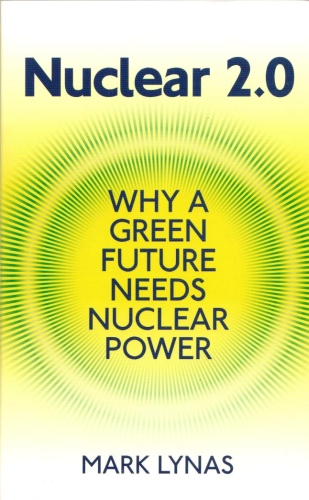

|
| Cover design by Richard Boxall |
| NUCLEAR 2.0 Why a Green Future Needs Nuclear Power Mark Lynas Cambridge, UK: UIT Cambridge Ltd., April 2014 |
Rating: 4.5 High |
|||
| ISBN-13 978-1906860233 | ||||
| ISBN 1906860238 | 111pp. | SC | $9.95 | |
As an environmental activist and writer who came of age contemporaneously with the anti-nuclear movement, Mark Lynas acquired a similar bias against power derived from atomic fission. But he changed his mind after attending an energy conference at Oxford University in 2005.
As I did so, I began to discover that most of what I had believed about atomic energy was inaccurate. I had thought that nuclear waste was an insoluble problem, that using civilian reactors raised the risks of nuclear war, and that radiation from accidents such as Chernobyl had killed tens of thousands or even millions of people. As I looked more closely at the scientific data, however, I found out that most, if not all, of the anti-nuclear ideas I had grown up with were either myths or misconceptions. In fact, here was a reliable power source with virtually unlimited fuel, which could power entire countries while producing no CO2 at all during its operation. I found myself in the difficult position of coming to believe that my children's future was threatened not just by the big fossil-fuel companies but also by professional anti-nuclear Green groups, many of which were staffed by my friends." – Pages 8-9 |
Nuclear 2.0 is the result. In it, he reprises the history that led to our current impasse, with many environmental groups adamantly opposed to any use of nuclear power. He points out the irony of this: phasing out all nuclear plants, as Germany is doing, forces the burning of more fossil fuels (primarily coal) than would otherwise be consumed. Yes, wind and solar are expanding rapidly and becoming cost-competitive with coal; but they supply tiny percentages of the world's energy. As population grows and third-world countries demand more energy, there is little chance that renewables can catch up in time to keep us below the 2°C limit. Renewables must be a part of the low-carbon energy system, certainly; but if we intend to meet our ambitious goals for emission reductions, nuclear must also play a part.
But what of the danger of reactor meltdowns? What of nuclear waste? What of the risk of proliferation?
Mark Lynas examines these downsides of nuclear power in Chapter 4, focusing mainly on the worst two accidents in civilian power reactors: Chernobyl #4 (1986)1 and Fukushima Daiichi 1-4 (2011).2 No one has yet died as a result of radiation exposure from Fukushima, while many have succumbed to immediate impacts of the tsunami or to mishaps during the subsequent evacuations. As for Chernobyl, the death toll stands at about 50, including 28 of the heroic workers who fought to minimize radiation leakage. Lynas reports that approximately 6,000 children in the area of the plant came down with thyroid cancer, but that only 15 died of the disease.3
The summary of his message is that a) nuclear power has gotten a bad rap. It certainly has its problems (as all energy sources do), but environmentalists often exaggerate the problems, and they fail to look closely at the progress the industry has made in improving safety, and b) despite the rapid advances made in solar and wind power, they cannot be ramped up in time to offset enough of our fossil-fuel use to stave off the worst effects of climate change.
Mark Lynas makes a persuasive case in Nuclear 2.0. It is a short book and an easy read. It does have a set of endnotes (available online as a PDF with live hyperlinks at Notes.) and an index. I rate it 4.5 and recommend it. I do not consider it a keeper, but rather a book you'll want to read and pass on.

 To contact Chris Winter, send email to this address.
To contact Chris Winter, send email to this address.